Driving advice, eco-driving
Driving advice, eco-driving
Introduction
Range is accredited in according to a standard regulatory method. Identical for all
manufacturers, this enables vehicles to be compared with one another.
Range in real time depends on vehicle usage conditions, equipment fitted and the user’s
driving style. To optimise range, please refer to the following advice.
Depending on the versions, you will be provided with functions which enable you to
lower energy consumption:
- on the instrument panel:
- the power meter;
- the driving style indicator;
- on the multimedia screen:
- data relating to your energy consumption;
- an energy consumption graph;
- scores based on your driving style;
- Eco driving advice;
- a route planner;
- a ECO driving mode.
Power meter
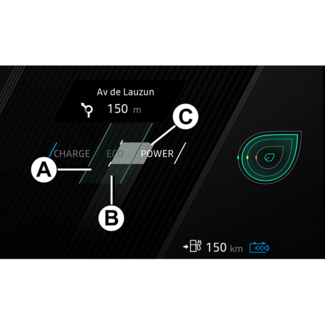
(on the instrument panel)
The charge meter gives you a real-time view of the energy consumed or recovered when
the vehicle is moving.
"Energy recovery" A usage zone
When driving, if you lift your foot off the accelerator pedal or press the brake pedal,
the motor generates electrical current during deceleration, and this energy is used
to slow down the vehicle and recharge the traction battery REGENERATIVE BRAKING SYSTEM.
"Optimal" B usage zone
Indicates economical driving, balanced between recovery and energy expenditure.
"Energy consumption" C usage area
The traction battery supplies the electrical energy required for the motor to move
the vehicle.
Tip
The presence and display of this information depends on the ambient setting selected
DISPLAYS AND INDICATORS.
Driving style indicator
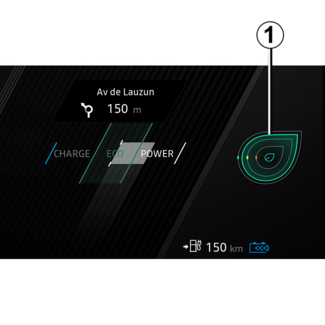
Informs you about the driving style adopted in real time. This is indicated by the
warning light 1.
You can display the driving style indicator by repeatedly pressing upwards/downwards
on the switch 2.
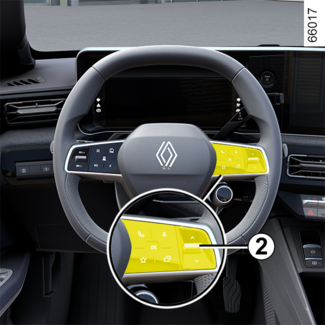
The larger the leaf displayed on the indicator 1 is, the better the management of speed, acceleration and anticipation in terms of
eco-driving.
The smaller the leaf displayed on the indicator 1 is, the worse the management of speed, acceleration and anticipation in terms of
eco-driving.
In the case of behaviour that is deemed unecological (small orange leaf), advice relating
to your driving habits may be sent to you.
If you regularly follow this indicator, you will increase your vehicle's electrical
range.
Journey record
On equipped vehicles, once the engine is switched off, a "Journey log" is displayed
on the multimedia screen 3. This log shows the information relating to your last journey:
- your average energy consumption;
- the number of miles/kilometres travelled;
- an overall grade taking into account acceleration, braking anticipation and your skill in managing speed;
- advice to enable you to improve your rating.
Please refer to the multimedia instructions for further information.
Navigation system
Using the information available on your navigation system (traffic information, nearest
charging station, etc.) makes it easy to manage your journey .
ECO mode
ECO mode is a function that can help you reduce consumption and increase range by acting
on the vehicle's performance (reduced acceleration and maximum speed, etc.).
Tip
Depending on the vehicle, the ECO mode also acts on the performance of the air conditioning.
Activation/deactivation using the switch 3

For vehicles equipped with it, press the switch 3 to activate the ECO mode.
Activation/deactivation from the multimedia screen 4
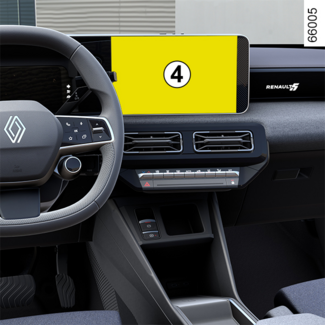
Depending on the vehicle, you can activate or deactivate the function from the MULTI-SENSE menu.
Please refer to the multimedia instructions for further information.
Activation/deactivation using the switch 5
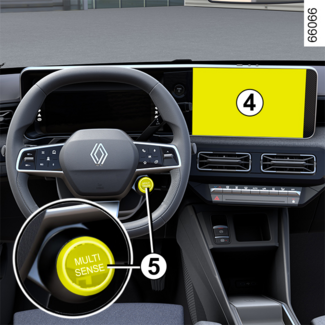
Depending on the vehicle, press the switch 5 as many times as required to reach ECO mode.

Tip
With ECO mode activated, the ECO warning light 6 is displayed on the instrument panel. The vehicle speed is limited to approximately
71 mph (115 km/h).
While driving, it is possible to exit ECO mode temporarily in order to improve the engine performance.
To do this, press the accelerator pedal firmly and fully. ECO mode is reactivated when you take pressure off the accelerator pedal.
Vehicle range: advice
In real usage, the range of an electric vehicle may vary depending on several factors
over which you have partial control, which may make a considerable difference to the
vehicle range.
These factors are:
- speed and driving style;
- road type;
- heating level;
- tyres;
- use of electrical accessories;
- vehicle loading.
Furthermore, activating ECO mode enables the vehicle to automatically take charge of all energy consumers (engine
power, etc.) in order to reduce their consumption to the fullest possible extent DRIVING ADVICE, ECO-DRIVING.
Speed and driving style
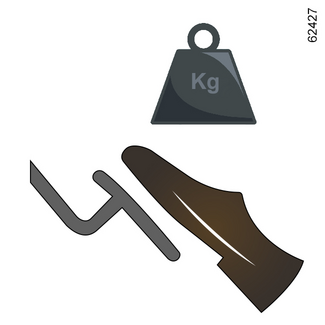
Driving at high speed will significantly reduce your vehicle's range.
Examples (at a steady speed):
- reducing the speed from approximately 80 mph (130 km/h) to 68 mph (110 km/h) allows you to save up to around 20% of fuel range;
- reducing your speed from approximately 56 mph (90 km/h) to 50 mph (80 km/h) allows you to save up to around 10% of fuel range.
"Sporty" driving reduces your vehicle's range: opt for a "smoother" driving style.
Advice:
- drive at a constant speed;
- keep an eye on the tools available to you to view the driving conditions (fuel gauge, current fuel consumption, journey record, etc.) DRIVING ADVICE, ECO-DRIVING;
- adapt your driving style to avoid excessive energy consumption;
- favour energy recovery: anticipate traffic changes by taking your foot off the accelerator pedal or braking gradually.
Road type
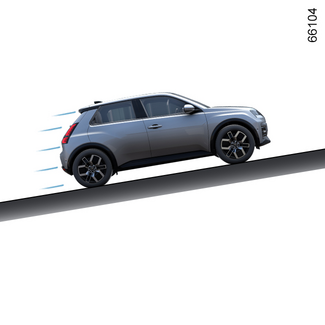
Do not try to maintain the same speed up a hill; accelerate no more than you would
on the level. Keep your foot in the same position on the accelerator pedal.
Heating levels
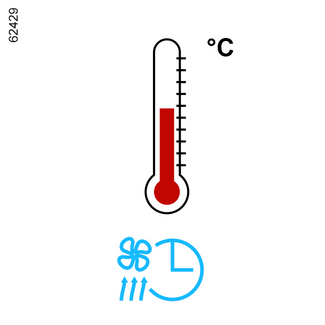
The use of heating or air-conditioning reduces vehicle range.
To maintain your vehicle range, we recommend that you select the "programming" mode
before using the vehicleAIR CONDITIONING: PROGRAMMING.
Vehicle loading
Avoid pointlessly overloading your vehicle.
Tyres
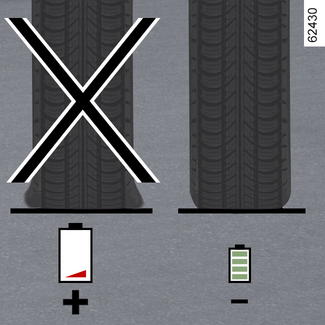
An under-inflated tyre increases energy consumption. Comply with the specified tyre
pressures for your vehicle.
When driving, use tyres made by the same manufacturer, with the same dimensions, type
and structure as the original tyres. The use of non-recommended tyres the vehicle range .